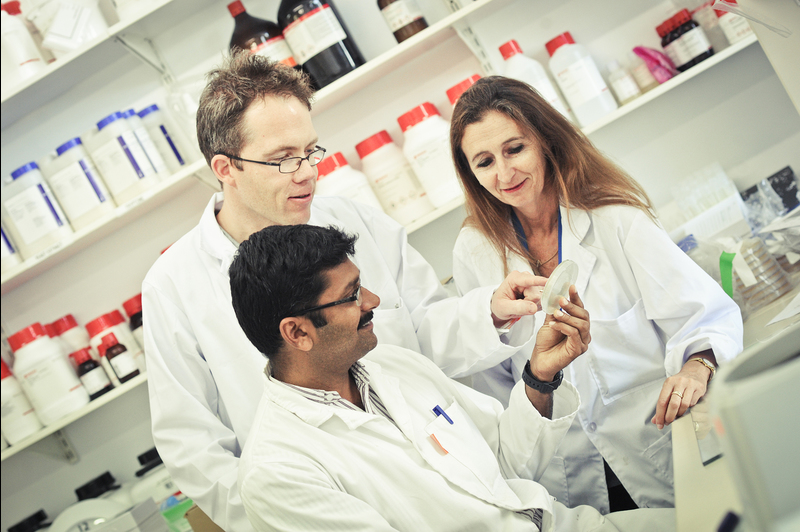Vitamin B12 transporter is key to understanding TB pathogen
15 April 2013
A paper published recently in Open Biology, a new journal of the Royal Society, has pinpointed a particular protein as the transporter of vitamin B12 in Mycobacterium tuberculosis, the bacterium which causes tuberculosis (TB). The finding represents an important contribution to understanding the ability of the TB bacterium to cause disease - in particular, the possibility that it has the capacity to scavenge vitamin B12 from its human host.
This research, which was led by a team of scientists from the Molecular Mycobacteriology Research Unit at UCT's Institute for Infectious Disease and Molecular Medicine (IIDMM), will also shape thinking in related areas of microbiological research: it turns out that the system used by the TB bacterium is quite distinct from previously known bacterial B12 transporters. Humans and plants don't make their own supplies of vitamin B12. It comes from a diet or food chain that includes 'contaminating micro-organisms'; in other words, bacteria that can manufacture the vitamin.
But not all bacteria make B12. Surprisingly, the TB bacterium is among those that can; yet it also comes armed with the ability to take it up from its host, possibly indicating the importance of vitamin B12 to the lifestyle of this major human pathogen. Plotting this pathway should have been easy for the scientists. However, the TB bacterium's transport mechanism is nothing like those found in common bacteria such as Escherichia coli, or salmonella. Instead, it is genetically related to human B12 transporters.
The uptake of vitamin B12 in the TB bacterium has long puzzled researchers working to prise open its defences. The protein, designated Rv1819c, provides new possibilities for interventions. The paper caps a four-year project that harnessed a multi-disciplinary team from research institutions in South Africa, Switzerland, Lithuania, and the US. A collaboration between UCT and the Swiss Federal Institute of Technology (EPFL) in Lausanne lay at the core of the work, and was funded by the Switzerland-South Africa Joint Research Programme, as part of a bilateral agreement between the Swiss and South African governments.
With IIDMM director Professor Valerie Mizrahi serving as the South African principal investigator on this Swiss-South Africa collaboration, it's another plaudit for the IIDMM, which will celebrate its 10th anniversary next year. The UCT team of Dr Digby Warner and postdoctoral research fellow Dr Krishnamoorthy Gopinath led the project, applying a combination of innovative genetic and molecular tools to identify the protein that transports vitamin B12 in the TB bacterium. Gopinath has a PhD in microbiology from the All India Institute of Medical Science in New Delhi - sister city of Johannesburg, where he first came to work as a postdoctoral research fellow in Mizrahi's previous research team at Wits University.
Warner followed an unlikely path to medical microbiology. He was an accountant at a paint and chemical factory, until one day he took a call on the helpline. The customer complained of peeling paint. The factory's chemist provided a simple answer: incompatible surface chemistry. This sparked a continuing fascination with science that saw Warner return to university, initially to study chemistry, and later, molecular biology.
At the IIDMM, the team does long-term work, trying to understand what makes the TB organism work at molecular and microbiological levels. In previous experiments, a US research group had tested a mutant strain lacking the Rv1819c protein in a mouse model of TB. They found that the mice became infected, but did not die as quickly. But they couldn't work out why.
"They didn't know what the protein did. We've shown that it's critically important for B12 uptake," said Warner. The findings are significant. TB is remarkably efficient; passing from one infected human to infect another, surviving and growing rapidly, primarily in the lungs. South Africa bears a huge TB burden, with approximately one per cent of the population affected by the disease. "In South Africa we are in the eye of the storm, as HIV provides fertile soil for TB and other opportunistic pathogens," said Warner. However, there's a twist to this microbiological tale. The fact that the TB bacterium is able to take up a huge molecule like B12 is a big surprise. It is renowned for its tough, almost impenetrable cell wall, which resists most molecules, frustrating those who work in drug development.
It's this question that will determine the future of Gopinath's research: does the TB bacterium also take up other forms of B12, perhaps in the form of B12 precursor molecules? If so, is the TB bacterium an opportunist rather than a scavenger? "The finding may not lead to a drug candidate, but it will provide some clues into how the TB bacillus takes up some very large molecules, and could shape thinking in other areas of microbiological research too," he said. The results also present a theoretical possibility: that biochemists can design TB drugs as conjugate molecules; in other words, antibiotics piggybacking on the B12 molecule - a chemical Trojan Horse, as it were. While there is always a translational component required in this kind of research (new drugs, etc), the excitement is that they are on the threshold of new knowledge.
"We don't know yet, but we're revealing new capacity of this organism that we're hoping will take us somewhere," says Gopinath. "It's about understanding the enemy," adds Warner.
 This work is licensed under a Creative Commons Attribution-NoDerivatives 4.0 International License.
This work is licensed under a Creative Commons Attribution-NoDerivatives 4.0 International License.
Please view the republishing articles page for more information.









